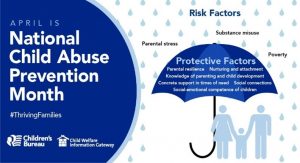Child Abuse Prevention Month: Information & Resources
As flowers burst forth during springtime, we may also see fields of silver and blue pinwheels, the National Child Abuse Prevention Month (CAP) icon used to spark conversations aimed at creating great childhoods for every child. During CAP, efforts focus on raising awareness and building community connections to provide tools to families, caregivers, and community members that are needed to prevent and effectively respond to all forms of child abuse.
It can be difficult to think about or discuss child abuse prevention, especially in the homeschooling community. The Organization of Virginia Homeschoolers works to provide resources and support to families and caregivers who choose to homeschool. We know that parents who homeschool make this choice because it is the best option for their children and family and we know that homeschooling can bring heightened scrutiny around our child-rearing practices. This fear of scrutiny can keep us from having difficult conversations, but it is important that all families learn about preventing child abuse and about how we can support each other in this work.
Child abuse happens in all kinds of households, for a variety of reasons, and can include neglect, physical abuse, sexual abuse, and other forms of maltreatment. For this blog post, we will be focusing on protective factors, or conditions that, when present in families and communities, minimize the likelihood of children being harmed and increase the well-being of children and families. Protective factors present at the individual level include things like caregivers who provide emotional support, caregivers who can meet a child’s basic needs, and caregivers who practice nurturing parenting skills. Relationship/family level protective factors include things like families having strong support networks and caring adults outside the family who can serve as mentors or role models. Other protective factors are present at the community and societal levels and can include things like accessible and affordable housing, accessible medical services, accessible and safe outdoor areas for exploration and skill-building, and financial and economic policies that benefit all families. For more on protective factors and an exploration of risk factors, visit the Centers for Disease Control and Prevention Violence Prevention website here: https://www.cdc.gov/violenceprevention/childabuseandneglect/riskprotectivefactors.html.
Even the most independent and autonomous children can experience child abuse when they don’t have the language to understand what is happening to them and when they don’t have a caring adult in their lives they can seek for support and aid. We can begin by teaching children proper names of their body parts and helping them understand consent and what it means to be in control of their bodies. And we can support each other in the homeschooling community because parenting isn’t easy and doesn’t come with a handbook for success that works for every child in every scenario. Sometimes homeschooling can make things more difficult, especially if we’re homeschooling in isolation. Luckily the Organization of Virginia Homeschoolers is here to provide ways to get connected with other homeschoolers across the Commonwealth and to create opportunities for all kinds of conversations that will ultimately ensure our homeschooled children can grow to be the confident, capable adults we know they will become!
For supportive resources or more information, click through to these organizations:
- Families Forward VA https://www.familiesforwardva.org/about-child-abuse-neglect
- Virginia Sexual and Domestic Violence Action Alliance https://vsdvalliance.org/
- Centers for Disease Control Child Abuse & Neglect Prevention https://www.cdc.gov/violenceprevention/childabuseandneglect/index.html
- U.S. Dept. of Health & Human Services Child Abuse Prevention Month https://preventionmonth.childwelfare.gov/topics/preventing/preventionmonth/

Opinions expressed by individual writers in this blog do not necessarily reflect the views of the Board of Directors of The Organization of Virginia Homeschoolers, nor do they represent an official position of VaHomeschoolers. Writers’ views are their own, and readers are encouraged to research and explore homeschooling issues to their own satisfaction.
